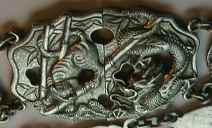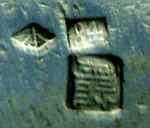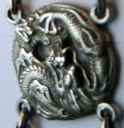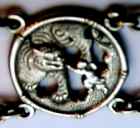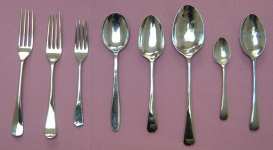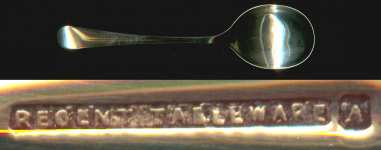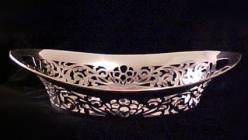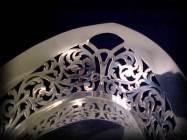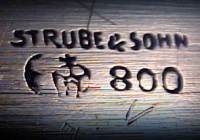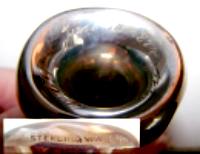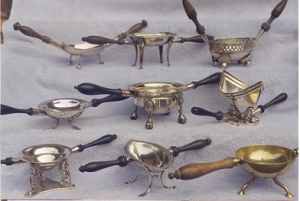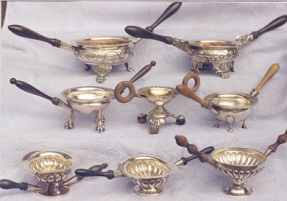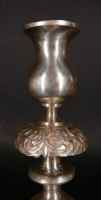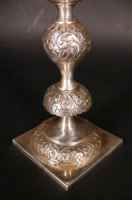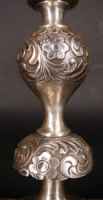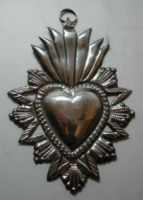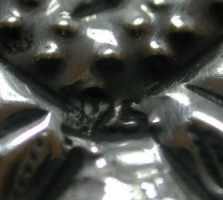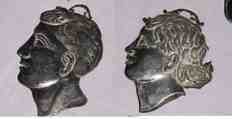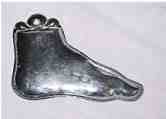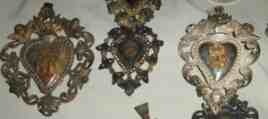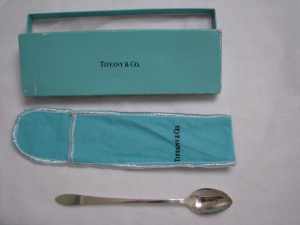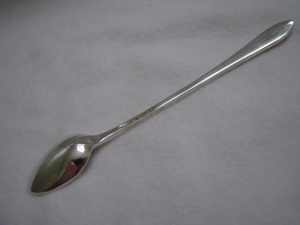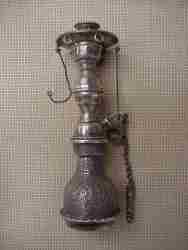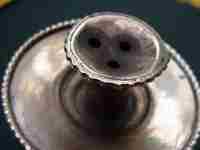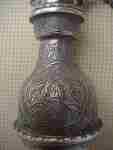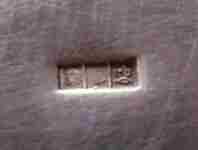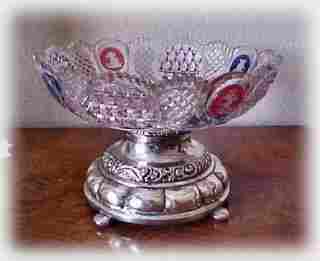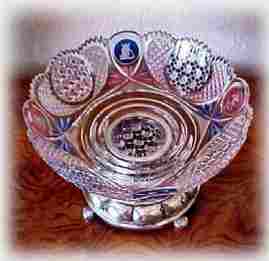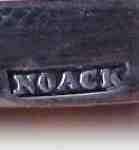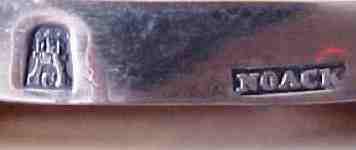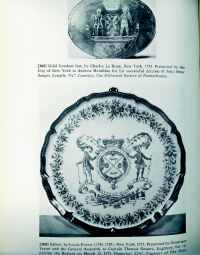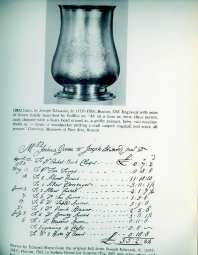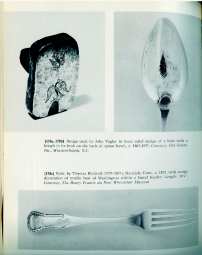| |
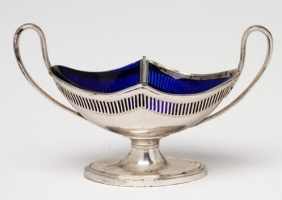
Rod Elser and Jane Carroll present:
Silver Open Salts at The Victoria & Albert Museum
(part 2)

This is 'part 2' of an article dealing with the
collection of silver open salts of the The Victoria and
Albert Museum -or just the "V&A" as it is more commonly
known- located on Cromwell Road in London and
established in 1852. Part 1 of this article was
published in January 2009 Newsletter. V&A collection of
salts spanned a period of manufacture of nearly 500
years -dating from the early 1500's to a very
contemporary silver salt made in 1979- and its policy
allows photographs (without the use of tripod equipment).
Other photos are published from V&A website with the
kind permission of the museum...
click here

|
| |
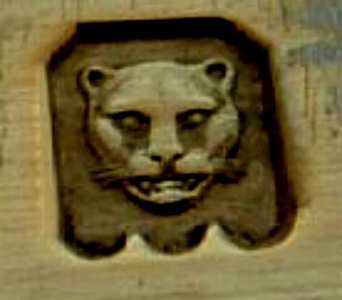
David McKinley presents
The Legal Position of The English Leopard

... I have felt constrained to write on this subject
because so many authorities continue to refer to the
leopard's head as the London mark without any further
clarification and to those not familiar with how both
the leopard's head and the sterling lion came into
existence this can be very confusing since patently
there is much plate assayed outside London which is
stamped with the leopard's head and equally there is
much plate assayed at Goldsmiths' Hall which, being of
Britannia standard, is not so marked......
click here

|
Welcome to new ASCAS members:
Bernard Begley - Australia
Craig Bennett - England UK
Hervé Cazaux - France
Marta Conte - Italy
Joan Fay - USA
Richard Hatton - England UK
Erinn Jackson Bryan - USA
Meg Lieberman - USA
Tony Mason - England UK
Todd O'Malley - USA
Andy Mawhinney - Germany
Deborah & Rodney Ralph - Australia
Jacqueline Rosen - USA
Cliff Wener - USA
Jennifer Youngblood - USA
Members' Window # 57
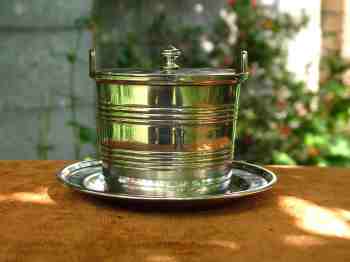
Prof. David N. Nikogosyan presents:
Marks of European Silver Plate: II. Fraget & Norblin

Visiting Moscow in 2000, I bought a strange
silver-plated object at the antique market "Izmailovo".
A rather small container in the form of a traditional
wooden Russian barrel with two compartments inside; the
upper one bearing a glass inset, was placed on the
silver-plated dish and covered by the lid. All three
parts (the container, the lid and the dish) were marked
by the same monogram AH (AN in Russian). Many of my
Russian friends and colleagues could not recognise the
purpose of this object. It took me a lot of time before
I understood what it was for - it was a caviar holder....
click here

|
Edward Doherty writes:
... I am seeking help with marks on a heavy cast silver belt
depicting, Tigers, & Dragons on a Bamboo.
First,..Have you any idea whereabouts this piece was produced.
Second,..What part does the Russian "84" mark play.
Finally,..Are the marks Chinese, Russian, or what?
Thanking you in anticipation.
kind regards,
Edward Doherty
I don't believe that your item is Russian.
I hope that someone of ASCAS members will be able to reply to
your questions.
Giorgio Busetto
Paul Shields writes:
... As a metal detectorist I have found your website a wealth of
knowledge on a subject I know almost nothing about. I have
identified many of my EPNS electoplated cutlery finds through
your hallmarks pages but are at a miss as to one particular
spoon and wondered if you could help?
The marks say REGENT TABLEWARE A. (in capitals) I'm not
interested in value but would like to attribute a maker and date
for this spoon.
Can you help?
Kind regards,
Paul Shields
Regent is a mark used by John Sherwood & Sons. Details
about this firm are available in my website at
http://www.silvercollection.it/electroplatesilverS.html
Giorgio Busetto
Kelli Rooney writes:
... I have found an interesting piece that is marked "Strube &
Sohn ", 800, with the half moon and crown mark of Germany after
1888. I'm having trouble locating information about this
particular silversmith.
The tray is 13.5" long, and weighs in at 390 grams.
Perhaps someone will know about this company, and the mark can
be used for further study?
Thank so much!
Kelli Rooney
I'm sorry but I have no information about this maker.
I'll publish your question in February Newsletter trusting in
thehelp of ASCAS members.
Giorgio Busetto
Sue Tiffin writes:
... I am curious to know what this long, thin, sterling piece
is. It is 10" long and is almost too thin for the stem of a
flower. It is open at both ends and will not stand alone. It has
been engraved around the inside of the top, "EGP, June 18, 1874
- 1899".
The hallmarks are Sterling, WW or WHW, 278. I thought of a
candle snuffer but haven't seen one straight like this piece.
Any help greatly appreciated!
Sue Tiffin
I believe that it is, possibly, a monaural stethoscope,
but I'm not sure. Anyway I'll publish your question in next
newsletter.
If so, a gift for a 25th anniversary of work or degree of a
doctor (an unlikely gift for a 25th wedding anniversary).
I hope to receive further information about your item and its
identification
Giorgio Busetto
Robert L. Downing writes:
... Giorgio:
Lately I have spent a good bit of time thinking about how best
to dispose of my collection of smokers braziers, AKA
pipelighters, when I am gone. I am 77 years old, in failing
health and have no wife or children. Because my background is in
research and education, I favor donating them to a university or
research museum that would use them to increase our knowledge of
the form and its makers.
Alternatively, I could use the money and might decide to sell
them. If so, should they be sold as one lot, thereby keeping the
collection intact or should I break it up and thereby put the
individual pieces back in circulation, available for purchase by
future collectors.
Every collector will eventually confront this problem and I
would like to hear what they decided to do and why. Are there
reasons to favor a university rather than a museum? Should the
items be returned to their country of origin, if possible?
Let your readers "kick this around" a bit, please.
PS To view most of my collection, search "google" for "smokers
braziers"
Robert L. Downing (bobpat@carol.net)
Above two images from Robert L. Downing website (http://members.carol.net/~bobpat/pipelighters.htm).
Your comments will be welcome
Giorgio Busetto
Dariusz Malinowski writes:
I recently purchased a silver candlestick which has the hallmark
like in attachment. The maker name is Szkarlat.
Can you help me in identifying the hallmarks.
Dariusz Malinowski
I'm sorry but I'm unable to identify the marks of your
Russian candlestick.
Any help will be welcome
Giorgio Busetto
Hymie Dinerstein writes:
I have the attached small piece of Italian (I think) silver and
I believe the maker is 'YL'
Looks like 1830's but what was it for? It is 4" tall and 3" wide
and weighs only 10 grams. Was it a religous piece worn by
someone?
It would be nice to know anything about it.
Regards
Hymie Dinerstein
Your item is an ex-voto. I do not believe it is Italian
as the letter "Y" do not exists in Italian alphabet and is
highly improbable an Italian first or last name beginning with
Y.
The ex-voto was offered to a church or to a sanctuary as a token
to a Saint or to Our Lady for a "grace received". The ex-voto
was often accompanied by a painting describing the episode (health
recovered, shipwreck, etc.).
Giorgio Busetto
Anthony Friedman writes:
I found your website, and I was very excited about the Tiffany
Hallmarks page.
I am trying to authenticate a Tiffany Faneuil Infant Feeding
Spoon (presumably, 1993 edition). The spoon is stamped on the
back "Tiffany & Co. Sterling". There are no other markings on
the spoon.
I took it to the local Tiffany and the saleswoman compared it to
the current edition and said that the spoon I have is not
authentic, because the current spoon is stamped "Tiffany & Co.
Spain .925". She said that all Tiffany silverware should say
.925. I know that some Tiffany pieces do not say .925 (I saw it
on your website). I also know that the stamps can change. Since
the saleswoman did not seem like she's worked at Tiffany for 15
years, I question her familiarity with the stamp from 15 years
ago.
Do you know if it is possible that a genuine 1993 edition
Faneuil Infant Feeding Spoon was stamped just "Tiffany & Co.
Sterling"? Alternatively, how can I find out what the stamp
should be on that spoon and whether there are variations in
stamps for that item.
Thank you very much in advance,
Anthony Friedman
Jose Rene Burgos writes:
... What is this object? From where it's coming from?
Regards Jose Rene Burgos
I believe it is a nargilé (narghilé), "a single or
multi-stemmed water pipe for smoking. Originally from India, It
has gained immense popularity, especially in the middle east. It
operates by water filtration and indirect heat and can be used
for smoking herbal fruits, tobacco, or cannabis" (information
obtained from Wikipedia).
The marks are Egypt, after 1916.
Giorgio Busetto
Replies to questions
Kelli Rooney
receives this reply about her silver and glass bowl
(see January Newsletter)
Charles C. Cage writes:
...Regarding Kelly Rudi’s Hamburg silver & glass
bowl in newsletter #56, Tardy’s listing of the Hamburg
assayer’s letters is very superficial. The letter "C"
here is from the third cycle of letters, and was that of
assayer Friedrich Christoph Greve, working 1829-1854.
The maker "NOACK" is Johann Friedrich August Noack (ca.
1788-1856), Master 1816 and retired 1847. The bowl,
therefore, can be dated to the more reasonable range of
1829-1847.
Best wishes
Charles C. Cage
"A PAGE per MONTH"
In this column we present a
page obtained from makers' brochures, books, auction
catalogs, advertising or whatever other printed paper
related to silver, which may be of interest for ASCAS
members.
The images will be published at a "low resolution" level
and for private and personal use only
This month ASCAS presents a 1900 advertising of Wm.
KENDRICK'S SONS, Jewelers and Silversmiths, 333 Fourth
Avenue, Louisville, Ky.
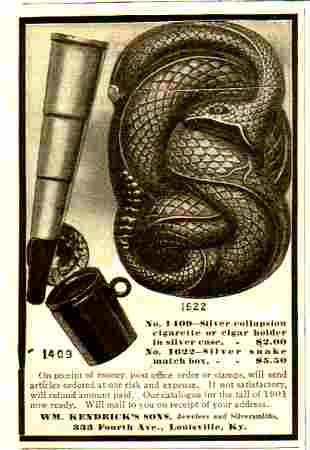
|
The leaflet advertises Silver collapsion
cigarette or cigar Holder in silver case ($
2.00), silver snake match box ($ 5.50).
" On receipt of money, money order or stamps,
will send articles ordered at our risk and
expense. If not satisfactory, will refund amount
paid. Our catalogue for the fall of 1901 now
ready. Will mail to you on receipt of your
address."
|
"A WORD per MONTH"
In this column we presents an
abstract from a page of the "What is? Silver Dictionary"
courtesy of

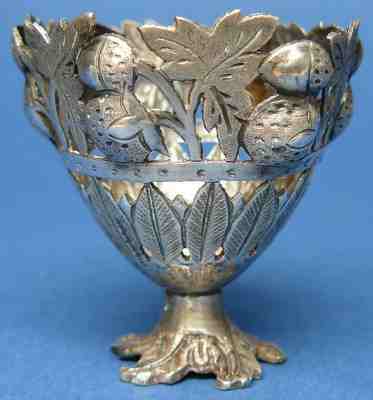
|
ZARF
COFFEE CUP HOLDER
A Zarf is a holder, usually of ornamental
metal, for a coffee cup without a handle.
Although coffee was probably discovered in
Ethiopia, it was in Turkey at around the
thirteenth century that it became popular as a
beverage. As with the serving of tea in China
and Japan, the serving of coffee in Turkey was a
complex, ritualized process. It was served in
small cups without handles (known as fincan),
which were placed in holders known as zarf (from
the Arabic word, meaning container, envelope) to
protect the cup and also the fingers of the
drinker from the hot fluid. Cups were typically
made of porcelain, but also of glass and wood,
however since it was the holder that was more
visible, it was typically more heavily
ornamented.........
more
|
"A BOOK ON MY SHELF"
In this column we present
books, new or ancient, dealing with silver in all its
aspects (history, marks, oddities...). This isn't a
"book review" but only a fair presentation of some
useful "tools" that anyone may have in the shelf of his
bookcase.
ASCAS members are invited to contribute to this column
(click to enlarge images)
The "book on my shelf" of this month presents:
EARLY AMERICAM SILVER
by Martha Gandy Fales
Excalibur Books
1970
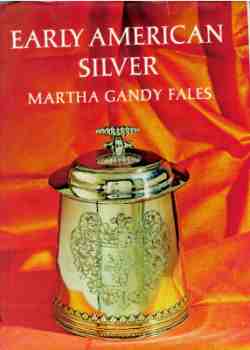 |
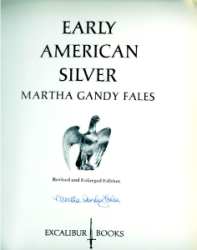 |
A commentator
writes about this book: The author surveys
the historical development of Americam silver
-including domestic silver, church silver,
official silver, and presentation silver,-
explaining why the various forms were developed
and why they disappeared, how they were used,
anf how they were made. She describes the
specific characteristics of different regions
and the work of different designers. She also
discusses the role of the American silversith
-his training, his shop and tools, the manner in
which he conducted the business, the allied
crafts that often engaged in- and gives a
fascinating picture of one of our country's most
important group of artisans.
|
Closing our FEBRUARY 2009 edition
of ASCAS Newsletter I hope you have appreciated its
content.
Your comments, suggestions and advice will be of great
help.
My thanks to
Jose Rene Burgos, Charles C. Cage, Hymie Dinerstein,
Edward Doherty, Robert L. Downing, Jayne Dye, Rod Elser,
Anthony Friedman, Dariusz Malinowski, David McKinley,
David N. Nikogosyan, Kelli Rooney, Paul Shields, Sue
Tiffin, JoAnne Wilkinson, for their invaluable
contributions.
Giorgio Busetto
Secretary
DISCLAIMER AND PRIVACY POLICY
ASCAS is a community of people having a
common interest in antique silver.
It is a non-profit association without
commercial links. Membership is open to whomever
has a true interest in this subject matter.
ASCAS has no real property and no fees are
requested nor accepted from members.
ASCAS keeps in touch with its members only
through periodical newsletters, e-mails and
web-site updating and ignores and is not
responsible for any other activity pursued by
its members.
Likewise, ASCAS is not responsible for opinions,
evaluation and images displayed, and in any form
published or supplied for publication, by its
members who, in any case, maintain the property
of their works and assure the respect of
national and international legislation about
Intellectual Property.
ASCAS does not have the full addresses of its
members (only town, country and e-mail address
are requested for membership).
ASCAS handles and protects with care its members
e-mail addresses, will not disclose the
addresses to third parties, will use this
information only to reply to requests received
from members and for communications strictly
related to its activity.
These rules are expressly accepted by submitting
the membership request.
|
|
|
|
|
|
 newsletter # 57 - FEBRUARY 2009
newsletter # 57 - FEBRUARY 2009




